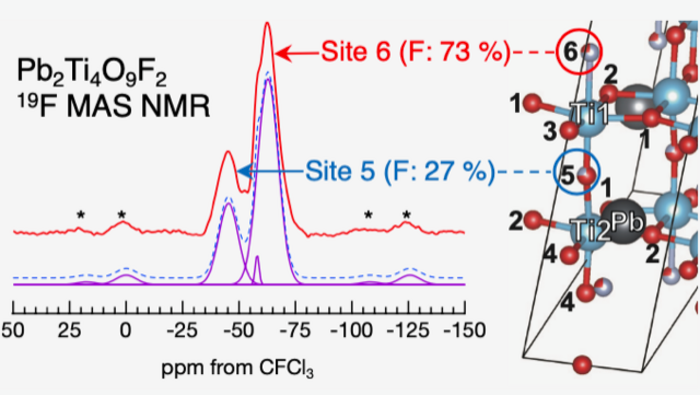Reviewed by Mila PereraOct 31 2022
Solid-state materials are extensively utilized in batteries, phosphors, and semiconductors and have become an essential part of modern life.

Waveform (left) and crystal structure model (right) obtained by nuclear magnetic resonance experiments of the composite anion material Pb2Ti4O9F2. The two peaks appearing in the waveform demonstrate the two types of atomic positions are selectively occupied when some of the oxygen in the original solid is replaced by fluorine. Using density functional theory-based calculations, the researchers explained the preference of fluorine occupation on these sites. Image Credit: Ryo Maezono from JAIST.
Substitution of elements in complicated composite materials is a standard method to obtain the desired material properties. Several properties can be obtained by partially exchanging oxygen in the oxide solid with another element such as fluorine (composite anion technology).
However, to tune material properties by substitution, it is essential to know the sites in the material where the element has been changed. If the substitution site is beside the highly reactive site in the solid, it favors the reaction that develops a certain material property.
Consequently, a research group headed by Professor Ryo Maezono from the Japan Advanced Institute of Science and Technology created an analytical tool to examine the ordering of fluorine in lead titanium oxyfluoride, a complicated composite material.
In a recent study reported in the journal Dalton Transactions on September 23rd, 2022, scientists report developing an interdisciplinary technique for clarifying the positions of substitution atoms in hard composite materials. To defeat the limitation of identifying substitution sites by experimental methods alone, the team utilized sophisticated computational simulations.
The scientists employed a simulation known as first-principles calculation (density functional theory) to examine the experimental outcomes and identify the element substitution positions present in the composite anion material.
We have established a method for clarifying the positions of substitution atoms in solid materials, which cannot be clarified only by experiments, by computer simulation.
Ryo Maezono, Professor, Japan Advanced Institute of Science and Technology
The research team has successfully determined the element substitution positions for composite anion materials where few of the oxygen atoms are replaced by fluorine. Simulations were executed using first-principles calculations for a crystal structure model with several element substitution positions, and every energy value was compared.
The outcomes illustrate that the substitution position providing the lowest energy value is the possible position for substitution. Additional simulations were performed using the crystal structure model with the substitution positions identified in this method, and outcomes consistent with the data noted in several experiments were achieved.
This study displays that in lead titanium oxyfluoride, the fluorine atoms predominantly occupied two of the six available inequivalent sites in a ratio of 73: 27. The scientists described the preference of fluorine occupation on such sites with the help of density functional theory-based calculations that corresponded to the experimentally observed occupation ratio.
Additionally, they describe that the lead atom valence electrons could identify the minority and majority fluorine occupation sites.
Utilizing the supercomputing facilities, quicker simulations can identify which substitution position has the least discrepancy with the experiment. This method complements experimental observations to completely understand the mechanism of anion order in complicated materials.
This outcome makes it possible to offer a strong analytical tool in the field of material development, in which atomic-level substitution is executed on solid materials and their properties are tuned.
The methodology developed in this work can accelerate the development of mixed-anion materials. Mixed-anion technique could realize better materials than the conventional mono-anion materials in semiconductor spintronics industries.
Ryo Maezono, Professor, Japan Advanced Institute of Science and Technology
Journal Reference
Oka, K., et al. (2022) Anionic ordering in Pb2Ti4O9F2 revisited by nuclear magnetic resonance and density functional theory. Dalton Transactions. doi.org/10.1039/d2dt00839d